Books &Commentary &Richard Williams 11 Mar 2010 08:58 am
Dick Williams’ Survival Kit
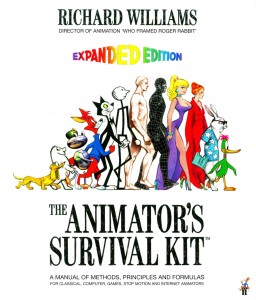 - Richard Williams, as we all know, was the genius who single-handedly fostered the renaissance of animation in the 60s & 70s. His London studio became the center of animation when the Disney studio faltered for that period.
- Richard Williams, as we all know, was the genius who single-handedly fostered the renaissance of animation in the 60s & 70s. His London studio became the center of animation when the Disney studio faltered for that period.
Or maybe we only know him as the author of that book, The Animator’s Survival Kit. That’s the book in which he has put his immense knowledge about the technique of animation, and there’s also his series of DVD lectures. Or maybe it’s the series of lectures and the companion book.
Recently released is the revised edition of the book which is at least 40 pages longer and includes a sample DVD to give an idea of his lecture series.
Both books are identical until page 339, the new book expands on the original. It talks about what Williams calls, “. . . the more difficult areas of animation,” such as animal action and gaits and offers suggestions on how to correctly use live action, to help push the medium further. (No mention is made of Motion Capture.) In fact, there’s a long piece comparing use of semi-realistic to cartoon animation.
The book says it’s for all types of animation from 2D to cg from puppet to highly rendered. However, to me, it feels more inclined to speak to the 2D drawing animator. I’m sure there are a lot of lessons the cg animator can and should take from the book, but I’m not sure how much use will be made of it.
Some of the lessons are excellent, but I wonder if others aren’t too sophisticated for those who will use the book to actually learn the craft. In fact, at first glance it looks like the Preston Blair book on acid, but Dick goes into a discussion about the Blair book and then builds on it, taking the material into a very complicated world. The delight is that Dick never sees his lessons as compicated, but moves straight on assuming we’ll all follow. The pages are hand lettered for the final 2/3 of the book, and this is particularly inviting for the artists out there. Howver, the drawings are dense with information and material and should not be confused with anything less than what they are. Richly informative.
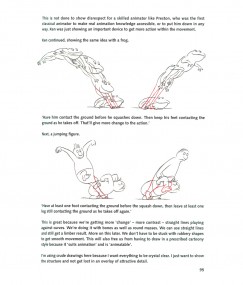 a
a 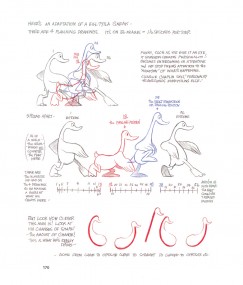 b
b
At first glance, the book looks like an update of the Preston Blair book, but
Dick takes on that point and builds from there leaving no doubt for the reader.
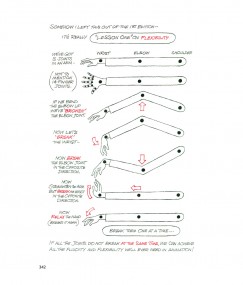 c
c 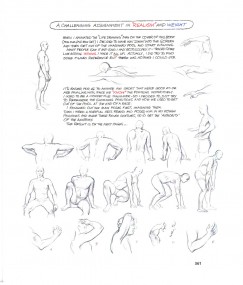 d
d
The additions are literally added to the end. 40 odd pages that are devoted
to more compicated motion patterns or things Dick left out the his original book.
It’s quite a tool if you use it well. A course, in itself, within the 380 pages. Every dedicated animator should own one, and then they own it they should read it.

on 11 Mar 2010 at 12:04 pm 1.David Nethery said …
I appreciate the expanded edition of the book very much.
A lot of the more complicated stuff in the book becomes clearer to the student if they have the opportunity to also watch the video lectures that are a companion to the book. I thought I was very familiar with all the material in the book , but even I had some “AH HA!” moments watching the videos when certain concepts became much clearer to me seeing them move as Dick describes the principle frame-by-frame and then in full motion. All animation schools ought to have a set that can be watched in the library (I would not let them be checked out of the library because it’s way too easy to duplicate DVDs ). For individuals the price of the DVD series is steep , but in my estimation is worth it. But the DVDs and the Book should go hand in hand.
Like you I enjoy Dick’s seemingly cavalier attitude of “just draw it like this and it’s simple”. He never for a moment assumes anyone reading the book or watching the videos won’t dive into it as deeply as he has. HIs explanation on the videos of how to animate the 8 legs of a spider is amazing. But the way he narrates it makes it sound as if it’s the easiest thing in the world if one just methodically breaks it down.
It’s interesting now that I’m teaching I find most student’s first introduction to Dick is via the book and they don’t know much about him beyond the fact that he wrote the book and directed the animation for Who Framed Roger Rabbit . Some dig a little deeper and find out that he worked on an animated feature for 25 years called The Thief and the Cobbler which was never finished except in a virtually unrecognizable , mangled form (“Arabian Knight”) but most are unaware of his other accomplishments. (if the students would just READ the first chapter of the book they’d find out a little bit more about Williams’s background and career, but I find very few will read beyond what is assigned and the parts that are required reading consist of mostly pictures.)
I’d love to see Dick release a high-quality DVD of the best of his commercial work from the 60′s 70′s and 80′s. Some amazing work on those commercials. I’d definitely purchase a DVD of his showreels. Maybe legalities prevent those from being released ? I know underground copies of those show reels float around on the internet , but most are third or fourth generation copies from 3/4 or VHS tape , so are not the best quality . If Dick has good quality masters of those spots it would be wonderful to see them released in high quality versions. Maybe if he just made the best of them available to view on his website as a retrospective of his career there wouldn’t be any legalities to deal with ? I don’t know . Dick has always struck me as someone who is not too interested in preserving his past work , but always looking forward. He’s famous for having thrown away a lot of his own artwork over the years, which thank goodness many of his collaborators had the foresight to save from the trash bin.
on 11 Mar 2010 at 12:22 pm 2.Michael said …
Very astute comments, David. I just assumed younger people wouldn’t really know much about Dick anymore. Too bad. He really did regenerate full animation in the 70s, and he brought hope to a lot of us back then.
You’re right about his commercials. In many ways, I think they’re some of the best work he’s produced. They seem, for the most part, to be lost.
The best way to see any of his work is on YouTube at The Thief Archive.
on 11 Mar 2010 at 12:23 pm 3.Richard said …
“technique of animation”
Yes. That’s what this book is. Great lessons for the mechanics of animation, but very little about the CHARACTER of animation. Williams isn’t known for his “character animation.” He’s known for incredible commercials, and feature work that moves around a lot.
it is very hard to learn and master the mechanics of animation. Let’s hope h is next book could focus on the most important part, Character Animation.
on 11 Mar 2010 at 2:14 pm 4.Michael said …
You’re correct, Richard, in that Dick’s mastery is in the technical aspects of animation without much of the warmth. This gift he’s passed on to most modern animators who seem to be able to create beautifully fluid movement without much of a heart behind it. Take a look at the Princess and the Frog for that.
Unfortunately, there’s no one who teaches how to put the real emotion into the character, and I’m not sure there ever was.
on 11 Mar 2010 at 2:38 pm 5.David Nethery said …
That part can’t be taught. That’ s the talent or the “soul” that an individual can put into their work.
That is the zen master’s “100th trick”. (see page 9 and 10 , Animator’s Survival Kit).
on 11 Mar 2010 at 3:21 pm 6.Richard said …
It’d be nice if Williams himself could do that (the soul part). Alas, even his best work remains more about technique than character.
on 11 Mar 2010 at 4:42 pm 7.Teodor said …
Nice example is Princess and the Frog.
I have a great, great, great respect to Richard Williams.
but, The Animator’s Survival Kit is to much theatrical for me
If animator can’t find alone solution about mechanics better to change job.
Preston Blair was enough in my case.I did not have anything else.No cal art etc,
on 11 Mar 2010 at 8:50 pm 8.Bill Perkins said …
Great Post Michael, and very true that we have him to thank for as you said “single-handedly fostering the renaissance of animation in the 60s & 70s”. Any of us that go back that far in the business know well how barren the landscape was of information and literature on animation. Today, by comparison there’s an embarrassment of riches animation literature wise on the shelves of most bookstores. I never worked for Richard William’s, but had the great good fortune to take part in his Animation Master Class in Los Angeles during the summer of 2000. I can’t recall ever being so completely riveted by anything or anybody as I was by him for all three days. It was impossible for your attention to drift. He was informative, engaging and entertaining all at the same time. What really came across was his enthusiasm for animation and great stories of working with Ken Harris, Art Babbitt, Grim Natwick et al. We owe him a very great deal.
on 11 Mar 2010 at 11:13 pm 9.Niki said …
I’ve had it for 3 years now and in my copy there is one major downfall, although it’s a damn good reference for an experienced animator, it doesn’t do much to help beginners, as in teaching the construction in animation that Preston Blair’s book does; the book in which he references in the frog and man’s jump. I haven’t been able to use it because I didn’t know the structure well enough, sop I’d recommend buying the Preston Blair book first and once you understand it Dick Williams’ will turn you from a good animator to a fine artist.
on 12 Mar 2010 at 1:55 am 10.Stephen Worth said …
Richard Williams was one of the “single hands”. The other was Bakshi.
on 12 Mar 2010 at 6:38 pm 11.David Nethery said …
Oh, hey, look at this: “ask and ye shall receive” .
Found this archive of British advertising. Search for “Richard Williams Animation” turns up dozens of ads (most by Richard Williams the animator, some live-action ads directed, presumably , by another Richard Williams) —
http://www.arrowsarchive.com/search.pl?searchterm=Richard+Williams+Animation
Similar searches for “Oscar Grillo” and “Eric Goldberg” also turn up some interesting items.
http://www.arrowsarchive.com/search.pl?searchterm=Oscar+Grillo
http://www.arrowsarchive.com/search.pl?searchterm=Eric+Goldberg
on 13 Mar 2010 at 5:31 am 12.Teodor said …
Thanks for the links
His comercials deserve another book.
Somethere in youtube was compilation of his awesome
comercials.
on 13 Mar 2010 at 2:33 pm 13.Louise said …
“The other was Bakshi.”
No, he was all thumbs. Bakshi’s only good as your opinion, which isn’t very well supported–as usual.
on 14 Mar 2010 at 7:11 pm 14.Stephen Worth said …
Well, if you would put your real name to that comment, we’d all know how useful your opinion is, “Louise”.